2013 $2 Dollar Bill Value: How Much is it Worth by Series?
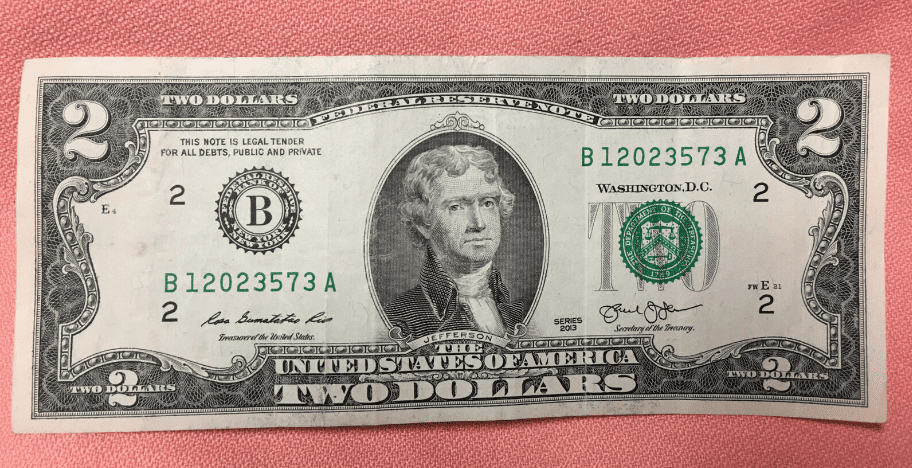
Have you come across a 2013 series 2-dollar bill and wondered whether it is worth much money?
You are not alone! Many Americans believe $2 notes are rare and can be sold for plenty of money. But the truth is, two dollar bills are not rare, with more than 1 billion in circulation to date.
Admittedly, we rarely see $2 bills in day-to-day transactions, which gives the impression that these coins are an oddity or rarity worth a fortune. But this is not the case.
However, some truly rare two-dollar bills can be worth hundreds or even thousands, depending on their condition.
We wrote this guide to demystify how much a $2 bill is worth. In particular, we will explore the 2013 series 2-dollar bill value and what you can expect whether you are selling or buying.
The History of 2 Dollar Bills
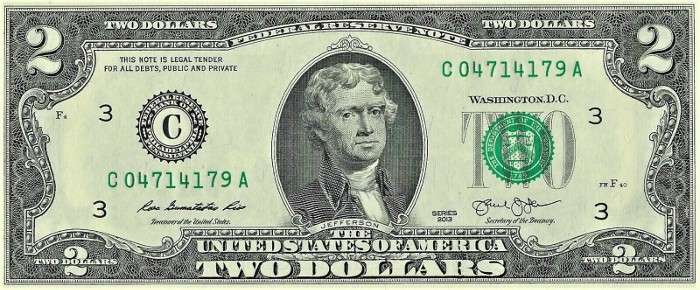
The United States government issued the first two dollar notes in 1862 as United States Notes, also known as Legal Tender Notes. These large-sized notes showed a portrait of Alexander Hamilton, the first Secretary of the Treasury.
In 1869, United States Notes underwent some changes, including $2 bills. The most notable one was the replacement of Hamilton with President Thomas Jefferson on the obverse.
In the 1928 series of United States Notes, Thomas Jefferson’s home, the Monticello, was featured on the reverse. The obverse and reverse designs remained the same for all $2 Federal Reserve Notes.
The Federal government introduced $2 Federal Reserve notes in 1976 as part of the United States Bicentennial celebrations. While Jefferson’s portrait remained the same, the depiction of Monticello changed to a vignette of the Declaration of Independence by John Trumbull.
The two dollar bills appear in various series depending on the design changes. These series include the 1976, 1995, 2003, 2003A, 2009, 2013, and 2017A. We will look at the 2013 series $2 Federal Reserve Notes value.
Features of the 2013 $2 Bill
Let’s now look at the unique features of the 2013 two-dollar bill on the obverse and reverse.
The obverse of the 2013 $2 Bill
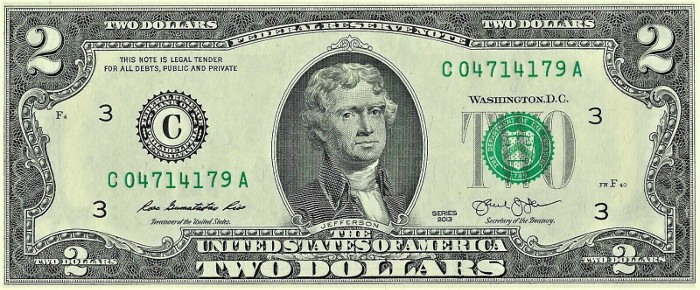
The obverse of the 2013 $2 federal reserve note features a portrait of President Thomas Jefferson with his name engraved just below the portrait.
The Federal seal appears on the right atop a bold TWO. The signature of the Secretary of the Treasury appears just below the seal.
A large letter appears on the left, signifying the issuing bank, while the signature of the Register of the Treasury appears below it.
The bill’s denomination, TWO DOLLARS, is shown on the lower margin.
The Reverse of the 2013 $2 Bill
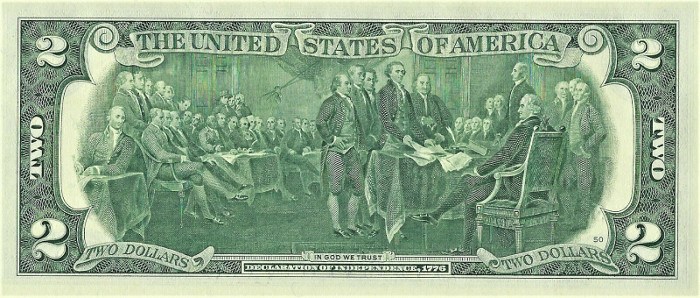
On the reverse of the 2013 two-dollar bill, you will find John Trumbull’s depiction of the signing of the Declaration of Independence.
The country’s name graces the top margin while the motto, IN GOD WE TRUST, appears further down just above the text, DECLARATION OF INDEPENDENCE.
You will also notice the coin’s denomination printed on all four edges of the two-dollar paper bill.
Other Features of the 2013 $2 Bill
The 2013 series $2 bills are issued as Federal Bank notes.
These notes weigh about 1 gram and are 0.0043 inches thick. Like all Federal Bank notes, the 2013 two-dollar bill measures 2.61 inches wide and 6.14 inches long.
These notes belong to the green seal variety.
2013 2 Dollar Bill Value Guides
In this section, we will answer the question: how much is a 2013 $2 bill worth?
Generally, your two-dollar federal note from 2013 will be worth its face value of $2 in circulated condition.
There is nothing special about uncirculated examples, either. The 2013 series $2 bills in uncirculated condition are worth about $4.
As you can see, there is little difference in the value of circulated and uncirculated 2013 $2 bills.
That said, star notes can be valuable, especially in uncirculated conditions. As the name suggests, star notes are paper bills with a tiny star sign at the beginning or end of the serial numbers on the note’s obverse.
Also known as Star Replacement Notes, these 2 dollar bills are rare, increasing their appeal to collectors. The Treasury included the stars to avoid serial number duplicity when replacing misprinted notes.
In addition to the condition, the issuing bank also plays a role in the value of a 2013 $ 2-star note. For example, a 2013 $2 star-note issued by the Federal Bank of New York is valued at about $20-$22 in uncirculated condition.
On the other hand, a $2 star-note from 2013 issued by the Federal Reserve of Atlanta is worth about $40-$45 in uncirculated condition.
You can tell the issuing bank by checking the initial on the front side of the bill on the left side. For example, a $2 bill issued from the Federal Reserve Bank of Atlanta will spot a bold A printed on it.
Rarity can also affect the value of your paper currency, including two-dollar federal notes. That said, the 2013 series $2 notes are not rare; there are more than 1 billion $2 bills in circulation, including the 2013 series, and more continue to be printed to date.
So, in this case, rarity is not a contributing factor to the value of your 2013 $2 bill. These notes are graded as abundant on the rarity scale, common in circulated and uncirculated.
2013 2 Dollar Bill Grading
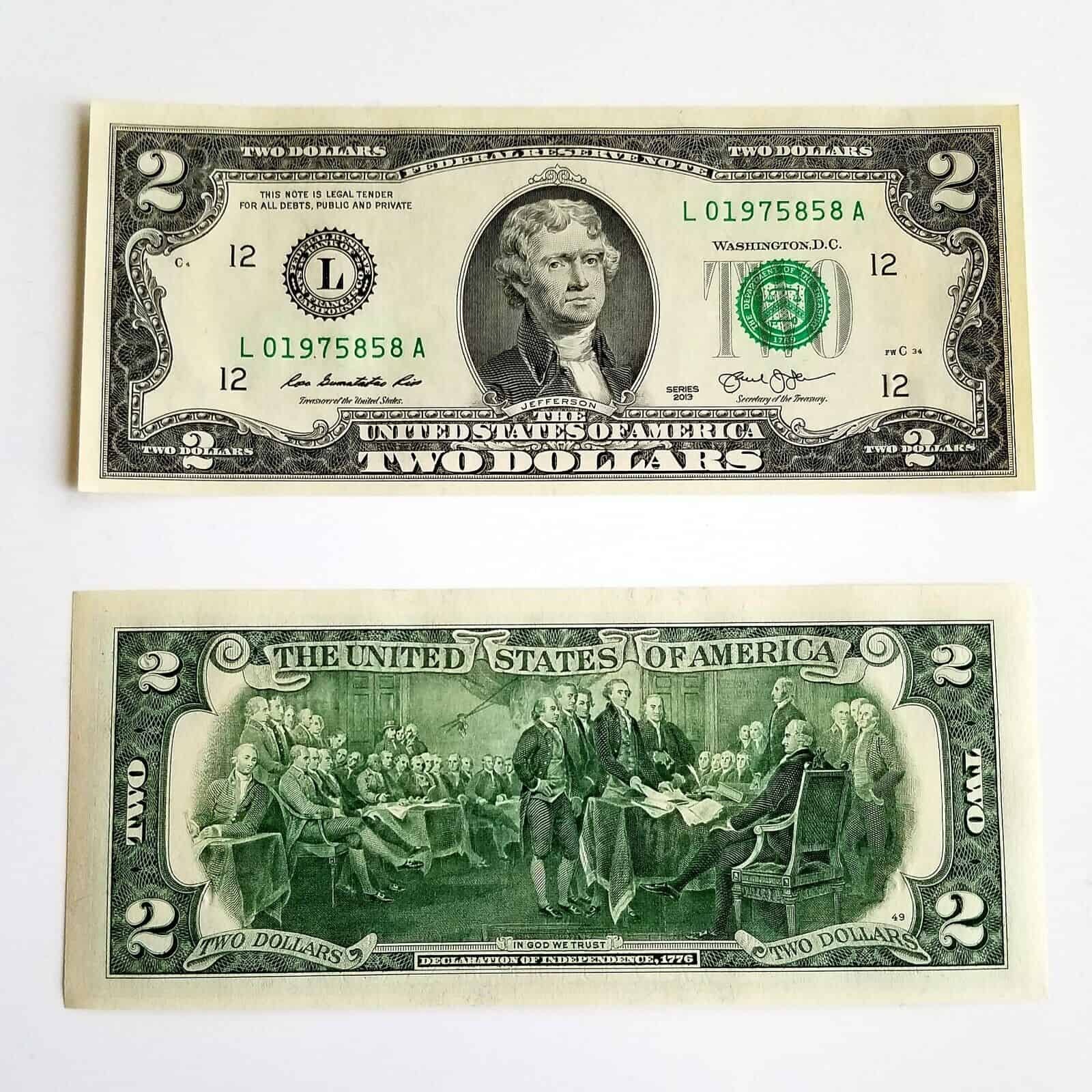
When grading paper bills, consider several factors; the same criteria apply to $2 notes.
These factors are the bill’s condition, rarity, serial number, and series. Ideally, uncirculated 2013 $2 are more desirable than circulated and worn examples. A crisp note will be more collectible than a worn one.
Check carefully for signs of wear when presented with a 2013 2-dollar bill. An uncirculated example should feel crisp, show strong ink detail, and demonstrate perfect centering of all design elements.
Rarity refers to the number of existing examples similar to the 2013 series of $2 bills. Regular $2 2013 federal notes are very common, with millions available in circulation. However, star notes in this series are rare and will be more valuable than regular $2 bills in the same series.
Next, the serial number will also influence the value of your 2013 $2 bill. Check for unique serial numbers such as those above 1000 or below 100, repeating numbers, and palindromes. Such serial numbers can significantly improve the value of your two-dollar bill.
2013 2 Dollar Bill Errors
There aren’t many major known errors in the 2013 series $2 bills.
That said, errors can show up anytime, and it helps to familiarize yourself with the most common ones so you can spot the potentially valuable $2 bills.
As a rule of thumb, major errors are more desirable and collectible.
Off-center Error
Off-center errors occur when two bills are improperly cut and wind up in the same frame. This causes the serial number and seals to shift away from the center. Uncirculated examples of off-center error federal notes can fetch as much as $2,000.
Stuck Digits
Stuck digits are an interesting error in which serial numbers are improperly printed during minting. This results in the numbers appearing slightly tilted or overturned.
Stuck digit errors are rare and will fetch $1,000 or more depending on the condition of your $2 bill.
Missing Ink
Paper bills go through three processes to get all the design details printed on the paper.
Sometimes, one of the three steps is skipped, resulting in some design elements, such as the seal or serial number, missing altogether.
A two-dollar bill with a missing ink error is worth about $1,000 to $2,000, depending on how much of the design elements are missing.
Gutter Fold Errors
Gutter fold errors are some of the most common but can still be valuable.
This type of error occurs when uncut sheets of currency printing paper are put through the press and a bank crease, also known as a wrinkle, appears on the paper.
When the paper is printed into currency, and the wrinkle shows up on the obverse or reverse, it is known as a gutter fold error.
This error is more desirable and valuable when it appears on the bill’s obverse, fetching as much as $200.
Fold Over Error
Fold-over errors occur when the corners of the currency paper fold accidentally and are printed as such.
This leads to parts of the note being blank, some obverse details being printed on the reverse, or serial numbers missing.
Fold-over errors are rare and may be worth $200-$500, depending on the extent of the misprint.
Blank Note Error
Also known as missing first print, this error occurs when the design elements on the bill’s reverse side are missing.
This typically occurs if one of the three printing steps is skipped and the design elements are not transferred onto the currency paper.
Depending on how much of the design needs to be included, a blank note error may fetch between $200-$2,000.
FAQS
Is there anything special about a 2013 $2 bill?
No. There is nothing extraordinary about the 2013 $2 bill. These notes have the same design elements on the obverse and reverse as the federal notes from previous years. However, your 2013 two-dollar bill may be special if it has a star on the serial numbers. These star notes are rare, desirable, and valuable.
How much is a 2013 $2 bill worth in 2023?
A 2013 $2 bill is worth its face value of two dollars in 2023 in circulated condition. Your bill may fetch about $4 in gem condition or several thousand if it is a star note or features a major known error. If you have an ordinary 2013 $2 bill, expect it to be only worth its face value.
Was the $2 bill printed in 2013?
Yes. The United States Bureau of Engraving and Printing (BEP) began printing 2013 series $2 2013 for the Federal Bank of Atlanta. These bills were issued for circulation in 2014 and remained in use until 2016.
